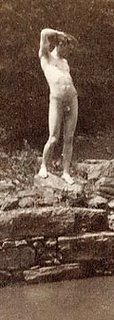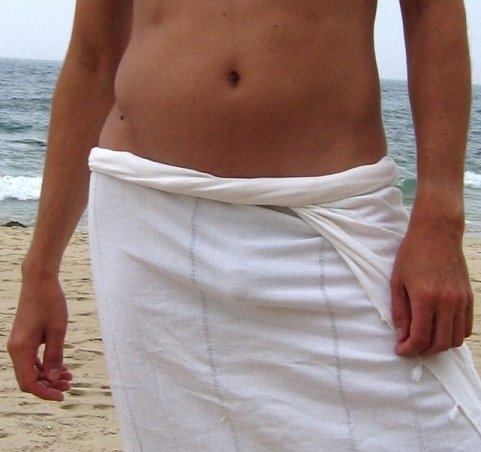Göz Lokum

 The above image has been the wallpaper on my work PC for several weeks. I don’t recall how I came across it, but it has become one of my favorite paintings. It’s called The Wrestlers (1899, oil on canvas, Columbus Museum of Art, Columbus, OH) and it was painted by Thomas Eakins (1844-1916). Eakins is well known as an artist of homoerotic subject matter and is best known for The Swimming Hole, which he painted in 1884/5. Originally called Swimming, the much beloved work was preceded by a series of photographic studies showing a nude and attractive Eakins (left) accompanied by his equally nude students frolicking at Mill Creek near Bryn Mawr, Pennsylvania.
The above image has been the wallpaper on my work PC for several weeks. I don’t recall how I came across it, but it has become one of my favorite paintings. It’s called The Wrestlers (1899, oil on canvas, Columbus Museum of Art, Columbus, OH) and it was painted by Thomas Eakins (1844-1916). Eakins is well known as an artist of homoerotic subject matter and is best known for The Swimming Hole, which he painted in 1884/5. Originally called Swimming, the much beloved work was preceded by a series of photographic studies showing a nude and attractive Eakins (left) accompanied by his equally nude students frolicking at Mill Creek near Bryn Mawr, Pennsylvania.I find it interesting that Eakins did not choose to portray these wrestlers nude. After all, I’m certain that by the late 19th century (and presumably much earlier), it was an established fact that young male athletes in ancient Greece wrestled in the palaestra au naturale. Whether they did in 19th-century Philadelphia is another story. Eakins himself was no stranger to nudes and painted (and photographed) many male nudes during his career as an artist. Perhaps Eakins sensed that there was a difference between painting a group of nude youths swimming and painting a nude youth pinned by another nude youth. As it was, Eakins’ use of photographic nude studies as drawing aids in the classroom drew criticism from his colleagues and he was fired by the Pennsylvania Academy of Fine Arts in 1886 for allowing a mixed class to sketch from a completely nude male model. Perhaps he was wary of the potential scandal that nude wrestlers would have aroused.
In spite of the fact that the subjects are not nude, The Wrestlers possesses an intense eroticism. To be sure, they’re not wearing much—they may not be bare, but they’re barely covered. Like many of Eakins’ paintings and photographs, The Wrestlers celebrates the beauty of the male form and invites the viewer’s gaze to linger over their lean bodies and taut muscles. Moreover, the scene suggests a sexual passivity as well, as the bottom wrestler is pinned and held passive and submissive by the victor on top. This sense of sexual conquest is heightened by the body contact, almost intimate in nature. Time and again, my eyes are drawn to the subtle way in which the winner’s right hand (holding down his opponent’s right hand) rests against the vanquished wrestler’s perineum.
During his time in France at the prestigious École des Beaux-Arts, Eakins was a student of Jean-Léon Gérôme, for whom he had great affection, though Eakins himself was critical of the French academy’s preoccupation with classical subjects. Eakins was also an admirer of Walt Whitman and painted a stunning portrait of the poet in 1887. While Whitman used verse to proclaim the beauty of the mail form, Eakins used the brush and the camera, and it’s not surprising that the two formed a lasting friendship. Nonetheless, Eakins’ erotic interest in males has proven even more difficult to pin down than Whitman’s. Eakins married fellow artist Susan Macdowell (1851-1938) in 1884.












12 Comments:
clothed or not, that is just such the amazing work.
:)
maybe this was practice which could have been clothed?
Oh and one more thing,we would like a rearview shot tomorow, I insist :)
Eakins was ahead of his time--a real pioneer as well as a superb artist. Even when his subjects are clothed and not in what you'd call homoerotic poses, his work celebrates being male, strongly and beautifully male.
even if there not naked its very erotic.
I am so using this for my wallpaper too! Thx.
Paul
thanks, guys, for the comments.
so it's agreed, clothed or not, it's quite hot.
brian-
did you wrestle in the 8th grade? :)
savante-
it makes awesome wallpaper!
Wow, I really liked this post. Coming from an Art Theory and History background (university, not work), I always appreciate other opinions and views.
Thomas Eakins has always been a favourite traditionalist of mine. I agree that his works are sensual, but they are sensual because they show the raw masculinity of the male nude form, not because of any homoerotic intentions. He was predominantly interested in depicting real life, raw, untempered and devoid of vanity. The fact that he was doing this in a non-sexual way, makes his works (in mine eyes) all that more intense and aesthetically beautiful. His being thrown out of the Pennsylvannia Academy, for removing a loincloth on a male model (for anatomical exactness), was a major sore point for him, because he believed his intentions were completely misunderstood, and that he was being persecuted for not painting things that matched the palette for established tastes. It was this whole snobbish bourgeoisie attitude that so many rebelled against later on.
BTW, I see you are in the Arts...thanks for sharing this information, and I look forward to reading more!
epicurist-
thanks for your comments, which were wonderfully insightful.
yes, i think you're spot on. i don't imagine that eakins intended his work to be homoerotic or possessed an awareness of its erotic quality (which it would have for a later generation of viewers). eakins lived during that transitional time during which men could create strong and even romantic bonds with one another, write each other love letters, swim naked together, and sleep in the same bed without there being erotic overtones to any of it.
the homoerotic meaning of such "normal" activities and of such images as eakins produced--and such verse as whitman produced--would be for a later generation to impose, a generation that had begun to develop a sense of the homosexual as distincly "other."
today, a celebration of the male form by a male artist would seem inherently gay. not so in the 19th century. eakins work has a much different meaning for us (whoever that is) today than it did back then.
thanks and i hope you keep reading and commenting :)
Yeah, that's a really good point. Eakins himself was not gay, and therefore the sexualisation of the male form was not psychologically infused, unlike say Paul Cadmus and his works (whom I find satirically and aesthetically wonderful). Male bonding did not achieve its heightened levels of machismo until this century, and male-bonding and affection was quite acceptable, as depicted in many literary pieces like Shakespeare's Sonnets, etc. Nowadays, depiction of any male-to-male bonding is eroticised.
I am confused by the label "homoerotic".
If a woman views the sensual male images and is aroused by them, is it still homoerotic?
The wrestlers are indeed sensual to a point, but they are not engaged in erotic activity. Body contact is the inevitable nature of wrestling, so I am hesitant to label any artwork "homoerotic".
Just plain "erotic" or "sensual" do fine for me and leave aside any pejorative meaning for those who are ready to pounce and criticize the work.
anonymous-
you'll notice that i referred to this particular work's eroticism, not its homoeroticism. i do, however, see it as a homoerotic work, because both of the subjects are men and their combat and body contact has an erotic element to it.
nevertheless, whether or not a work possesses homoeroticism has nothing to do with the gender of the viewer. that doesn't mean that every viewer will perceive or appreciate its homoeroticism.
Post a Comment
<< Home